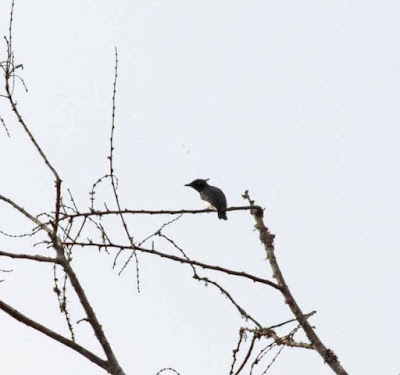Raptors are a popular group of birds to see due to their size and the power they project. Many countries have hawks or eagles or vultures as national birds. In Africa their are an amazing number of raptors to be seen compared to North America. Omitting the falcons, the East Africa Guide Book for Kenya, Uganda Tanzania list 63 species. Sibley has just 24 in North America. In addition, many live in protected parks and they can be approached in a vehicle rather closely for great photos.
Three harrier species were photographed including 2 migrants from Europe. The 18" immature Pallid Harrier (Circus macrourus) is dark brown above and rust below. He also has a white rump like many harriers.
 |
| Pallid Harrier - immature |
 |
| Montagu's Harrier - male |
 |
| African Marsh Harrier |
The 24" Black Kite (Milvus migrans) was often seen flying, but seldom perched. He is actually brown in color and in the morning light had a reddish color in the photo.
 |
| Black Kite |
 |
| Common Buzzard |
The 24" Augur Buzzard (Buteo augur) comes in a dark morph and a light morph. he has a red tail like our Red-tailed Hawk. Here is an adult dark phase bird. The red in the taill is best seen when the bird is flying.
 |
| Augur Buzzard - dark morph |
 |
| Augur Buzzard - juvenile light morph |
 |
| Lizard Buzzard |
 |
| Grasshopper Buzzard |
 |
| Dark Chanting Goshawk |
The 12" Shikra (Accipiter badius) I had seen in China but did not get a photo. This bird let me walk right up to her. This is a female with the orange eyes. The male has red eyes. The name Shikra is unusual and it comes from Indian - meaning hunter
 |
| Shikra - female |
 |
| Black Sparrowhawk |
One thing that has interested me for a long time are national birds. Now that I have done photography on several continents, I decided to look up national or official territorial birds. Some places do not have designated birds, so if they have the bird on their coat-of-arms, I used that bird. Despite the fact I have I have photographed in just a dozen countries, I have photos of the birds of 83 countries or territories.
I did the same for the USA states and territories as well as the Canadian provinces. You can see them here.
I put the different bird/mammal families in single folders for easy viewing
I have photos of 72 of the 254 species of hawks, eagles, kites
Happy birding and photography,
David McDonald
dkmmdpa@gmail.com
photos copyright 2006 - 2020 David McDonald
To have these trip reports sent to your email, please email me at the above address and ask to subscribe.
I put the different bird/mammal families in single folders for easy viewing
I have photos of 72 of the 254 species of hawks, eagles, kites
Happy birding and photography,
dkmmdpa@gmail.com
photos copyright 2006 - 2020 David McDonald
To have these trip reports sent to your email, please email me at the above address and ask to subscribe.

































